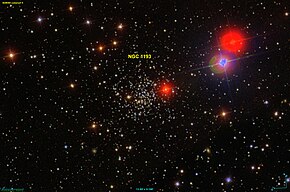| NGC 1193 | |
|---|---|
 | |
| Observation data (J2000 epoch) | |
| Right ascension | 03h 05m 55.0s [1] |
| Declination | +44° 23′ 00″ [1] |
| Distance | ~14024
ly from the sun (4300 pc) [2] |
| Apparent magnitude (V) | 12.6 [1] |
| Apparent dimensions (V) | 3.0 arcmin [1] |
| Physical characteristics | |
| Other designations | OCL 390 [1] |
| Associations | |
NGC 1193 is an open cluster in the Perseus constellation. [1] It was first observed and catalogued by astronomer William Herschel in 1786. [3] The cluster is estimated to be approximately 4.2 billion years old. [4]
NGC 1193 is usually classified as a Trumpler type II3m, [5] indicating its stellar population have a wide range of brightness, from very bright to faint stars and little star concentration in the center of the cluster. The letter 'm' on the Trumpler classification indicates a population of 50 to a 100 stars. However a study released in 2022 [5] indicates a population of approximately 181 stars in the cluster, possibly changing the type from II3m to II3r. A photometric study of this galaxy carried out in 1988 revealed a small population of 5 blue straggler stars, a number of subgiant branch stars and red giant branch stars. [5]
- ^ a b c d e f "Revised NGC Data for NGC 1193". spider.seds.org. Retrieved 2023-12-06.
- ^ "WEBDA result for NGC 1193". webda.physics.muni.cz.
- ^ "revised Herschel catalogue". www.klima-luft.de. Retrieved 2023-12-06.
- ^ Salaris, M.; Weiss, A.; Percival, S. M. (2004-01-01). "The age of the oldest Open Clusters". Astronomy and Astrophysics. 414: 163–174. arXiv: astro-ph/0310363. Bibcode: 2004A&A...414..163S. doi: 10.1051/0004-6361:20031578. ISSN 0004-6361.
- ^ a b c Yontan, T.; Çakmak, T.; Bilir, S.; Banks, T.; Raúl, M.; Canbay, R.; Koç, S.; Taşdemir, S.; Erçay, H.; Tanık Oztürk, B.; Dursun, D. C. (2022-10-01). "A Study of the NGC 1193 and NGC 1798 Open Clusters Using CCD UBV Photometric and Gaia EDR3 Data". Revista Mexicana de Astronomía y Astrofísica. 58 (2): 333–353. arXiv: 2207.06407. Bibcode: 2022RMxAA..58..333Y. doi: 10.22201/ia.01851101p.2022.58.02.14. ISSN 0185-1101.
| NGC 1193 | |
|---|---|
 | |
| Observation data (J2000 epoch) | |
| Right ascension | 03h 05m 55.0s [1] |
| Declination | +44° 23′ 00″ [1] |
| Distance | ~14024
ly from the sun (4300 pc) [2] |
| Apparent magnitude (V) | 12.6 [1] |
| Apparent dimensions (V) | 3.0 arcmin [1] |
| Physical characteristics | |
| Other designations | OCL 390 [1] |
| Associations | |
NGC 1193 is an open cluster in the Perseus constellation. [1] It was first observed and catalogued by astronomer William Herschel in 1786. [3] The cluster is estimated to be approximately 4.2 billion years old. [4]
NGC 1193 is usually classified as a Trumpler type II3m, [5] indicating its stellar population have a wide range of brightness, from very bright to faint stars and little star concentration in the center of the cluster. The letter 'm' on the Trumpler classification indicates a population of 50 to a 100 stars. However a study released in 2022 [5] indicates a population of approximately 181 stars in the cluster, possibly changing the type from II3m to II3r. A photometric study of this galaxy carried out in 1988 revealed a small population of 5 blue straggler stars, a number of subgiant branch stars and red giant branch stars. [5]
- ^ a b c d e f "Revised NGC Data for NGC 1193". spider.seds.org. Retrieved 2023-12-06.
- ^ "WEBDA result for NGC 1193". webda.physics.muni.cz.
- ^ "revised Herschel catalogue". www.klima-luft.de. Retrieved 2023-12-06.
- ^ Salaris, M.; Weiss, A.; Percival, S. M. (2004-01-01). "The age of the oldest Open Clusters". Astronomy and Astrophysics. 414: 163–174. arXiv: astro-ph/0310363. Bibcode: 2004A&A...414..163S. doi: 10.1051/0004-6361:20031578. ISSN 0004-6361.
- ^ a b c Yontan, T.; Çakmak, T.; Bilir, S.; Banks, T.; Raúl, M.; Canbay, R.; Koç, S.; Taşdemir, S.; Erçay, H.; Tanık Oztürk, B.; Dursun, D. C. (2022-10-01). "A Study of the NGC 1193 and NGC 1798 Open Clusters Using CCD UBV Photometric and Gaia EDR3 Data". Revista Mexicana de Astronomía y Astrofísica. 58 (2): 333–353. arXiv: 2207.06407. Bibcode: 2022RMxAA..58..333Y. doi: 10.22201/ia.01851101p.2022.58.02.14. ISSN 0185-1101.